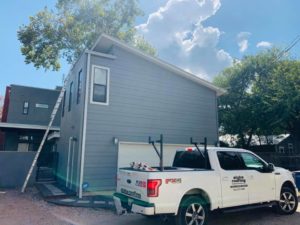 Having a licensed roof contractor perform a complete roofing system inspection will uncover any problems that require immediate repair. Problems caught early are easier and less expensive to repair. Left unrepaired, minor damage can quickly escalate into costly major damage.
Having a licensed roof contractor perform a complete roofing system inspection will uncover any problems that require immediate repair. Problems caught early are easier and less expensive to repair. Left unrepaired, minor damage can quickly escalate into costly major damage.
How Often Should You Ask an Austin Roofer to Inspect Your Residential Roof?
For Austin residential roofing, your contractor may recommend that you have a professional roof inspection performed at least twice a year. A thorough roof inspection should also be performed after any occurrence of severe weather involving high winds or hail. Older roofs may need to be inspected more frequently. Many well-established, reputable roofing companies offer preventive maintenance programs that include periodic roof inspections as part of their roof services.
What Are the Elements of the Type of Roof Inspection Austin Homeowners Need?
A thorough roof inspection should include an examination of both the exterior and interior of the home. The inspection should consist of all or most of the items on the following lists.
• Exterior Roof Inspection: All exterior components of the roof system are carefully examined to determine their condition.
1. Gutters: The gutters and downspouts are an critical component of a roof system. Gutters need to catch and direct runoff to the downspouts adequately, and the downspouts need to disperse this water well away from the foundation of the home. Broken or missing sections will need to be repaired or replaced. Clogged gutters and downspouts will need to be cleaned. The roofing inspector will take notice of any accumulation of shingle granules inside the gutter and on the ground around the downspout exit points. Some granule accumulation is normal, but excess accumulations could signify that your shingles need to be replaced soon.
2. Trim: Fascia boards and soffit trim around the roof will be examined for damage. Any damaged or missing pieces will need to be repaired or replaced. Damaged trim around the roof can allow water to enter the home, leak into wall voids, or penetrate the structure of the roof. Insects and other pests can also find entry into the attic or thorough home openings in the trim.
3. Roofing Material: The roof inspector will access the roof and examine the condition of the roofing material. Some shingles may need to be replaced, or a total replacement may be necessary. For metal roofs with panels, joints and seams need to be waterproof. The screws that secure metal panels can work loose over time, so the inspector will check whether they are correctly fastened.
4. Flashing: All flashing needs to be present, intact, and sealed. This includes flashing around vents, skylights, valleys, dormers, eaves, rakes and chimneys.
5. Foliage and Debris: Debris will need to be removed from the roof. Standing debris can trap moisture and result in the growth of algae, moss, and mold. Algae and moss can cause damage to asphalt shingles and create an unsightly appearance on any roof. Tree limbs and other types of foliage that hang over or touch the roof need to be trimmed back. Broken tree limbs can severely damage a roof, and foliage that touches the roof can result in damage to the roof material.
• Interior Roof Inspection: Several areas of your home can contain hidden signs of roof issues, but the attic is often the first area to reveal evidence of problems. Therefore, the roofing contractor will want to access your attic to determine if any interior damage has occurred and if water is present.
1. Structural Elements: Roof decking, rafters, joists, and other structural components will be examined for damage, including rot, mold, mildew, or loss of integrity. Structural integrity is especially important. A compromised structural system can cause significant damage, and structural damage may cause the home to be uninhabitable due to safety issues.
2. Insulation: Insulation in the attic needs to be adequate to help control comfort within the home. Damaged, wet, moldy or mildewed insulation can be evidence of a leak and should be replaced.
3. Ventilation: Proper ventilation of the attic is necessary to control temperatures and humidity levels for comfort, but controlling humidity also helps inhibit the growth of mold and mildew. Inadequate ventilation can also be grounds for the manufacturer of the roofing products used on your home to deny a claim if the products fail.
Alpha Roofing, a highly respected roofing company serving Austin and many locations in Central Texas, offers damage inspections as well as preventive roofing maintenance programs. Our roofing services also include the installation of metal roofs, flashing, skylights, and asphalt shingles, and we repair chimneys, roofs, and flashing. We also offer metal fabrication, moss and debris removal, flat roof replacements, emergency roof repairs, and commercial roofing services. We are known for our exemplary customer service and exceptional craftsmanship, yet our prices are extremely competitive. To request a free quote, fill out the online form, or call us at 512-777-1086.
